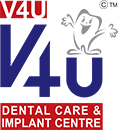PERIODONTAL/GUM TREATMENT
Get in touch with us today!
This specialist deals with the pink factor of the smile namely gums and lips. They make sure that the pearly whites are well supported by the classy pink for the dynamic smile. These specialists are also concerned with the treatment of cosmetic treatment of gums and placing dental implants. They make sure that..
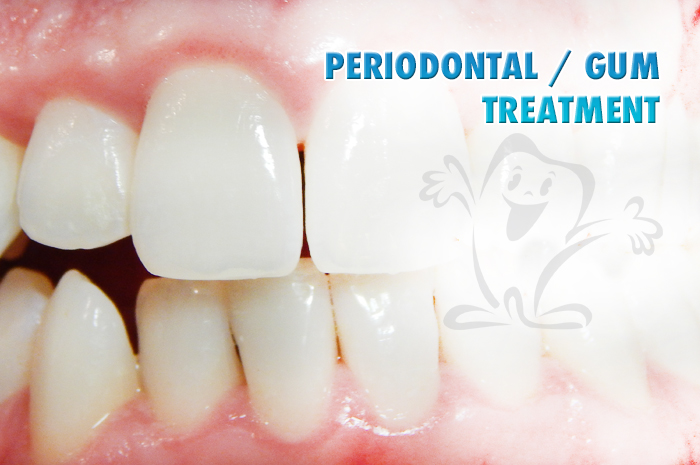
They make sure that the teeth are well supported by the gums and bone that act as an anchorage for the teeth. They play an important role in pre-prosthetic surgeries too i.e. any correction required to place dentures either removal or fixed. Thus they yield magic by reconstructing the lost gums or removing the dirt from the teeth to make the smile as pleasing as possible.
A) Treatment Of Gum Diseases
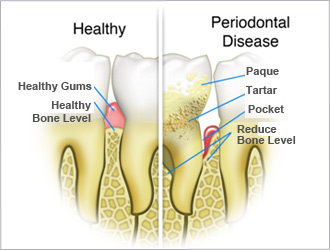
They are of two types: gingivitis and periodontitis.
Gingivitis is inflammation of the gums alone due to the dirt accumulated on the teeth. It causes red, swollen gums that can bleed on manipulation. Sometimes pus exudation can be present. The patient can also complain of bad breath.
Periodontitis is caused if gingivitis is not treated properly. Here the teeth become sensitive, the gums recede and after sometime the teeth become mobile. There can be pus exudate and the gums start bleed spontaneously. There can also be movement of the teeth due to bone loss.
Periodontal disease can also be caused by aggressive tooth brushing habits or by using hard bristled brush that cause trauma to the gums eventually receding them from their original position. Here the supporting bone is not lost due to tartar accumulation on the teeth but by the faulty brushing habit. In such cases the teeth may be completely clean but the gums would have fallen from their position.
Periodontal problems are multifactorial in nature. The main reason can be the accumulation of bacteria on teeth in the form of sticky plaque that cannot be removed by brushing. If it is not removed then the bacteria release toxins in the gums that cause them to redden and swell. Prolonged ignorance leads these toxins to enter the bone destroying it and making the teeth mobile which eventually fall.
Other reasons can be grossly decayed teeth, over contoured restorations or overhanging margins, mouth piercings and rough surfaces that provide a niche for bacteria to grow.
Negative habits like smoking, drinking, stressed lifestyle can all reduce the immune system of the body making it more susceptible to periodontal disease.
Systemic diseases like diabetes, hypertension, continuous drugs, immunosuppressants all these conditions also alter the immunity.
Genes can play a major role in acquiring periodontal diseases.
Hormonal fluctuation in females during menstruation, pregnancy, while using contraceptives also harm the periodontium.
Any form of tobacco can hinder the immunity and delay healing, increase the rate of formation of calculus, thus promoting periodontal diseases.
This disease is an irreversible process, thus further loss of the structures can only be prevented which is very important. In case of any symptoms mentioned earlier do visit us immediately and get a through diagnosis of the extent of destruction that has occurred. As this process is not painful lot of people tend to ignore these signs and then have to lose their precious teeth. Dr. Khushboo Desai is a specialist of this branch and she would explain to you the reason behind the disease and the possible ways to cure it.
Once you get yourself checked by our highly skilled Dr. Desai she will ask for various investigations like full blood report incase of any systemic diseases and x-rays will be taken along with clinical examination. If she suspects bone loss in all the teeth she would recommend an OPG for complete bone view. Thereafter based on the bone loss patterns as viewed in the X-ray she would proceed to form the treatment plan and explain it in detail to the patient.
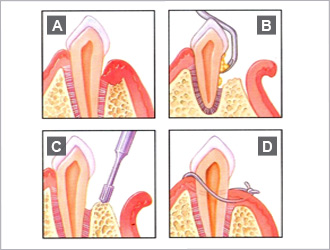
A) Supportive bone around the root is disease and partially destroyed.
B) First, plaque and tartar are removed from the infeacted pocket.
C) The bone is smoothed and reshaped, reducing spaces where bacteria can grow. A substance may be used to help the gum attach ti the tooh.
D) The gum is then closed over reshaped bone at or below the original gumline.
Incase if our specialist thinks it necessary to perform the surgery then a full mouth thorough scaling will be carried out on the first day to remove all plaque and calculus from the teeth and give the gums some time to heal from the exposure of the toxins. The surgery would be scheduled after a week so that the gums become disease free and strong. After that local anaesthesia is applied to numb the gums and teeth in the region where the procedure has to be performed. After attaining complete anaesthesia the gums are incised and raised from the bone with the help of an elevator. After that all the granulation and infected tissues are removed from the bone and gums with specialised instruments called curettes. Any tartar present on the root of the tooth is removed with the scaler and after thoroughly disinfecting the area with saline and povodine iodine the gums are placed back on the same position and sutured. The patient is informed to report back after a week to remove the sutures.
The patient is informed that the numbness in the region would be present for around one hour. During that time do not chew the lips or cheek. The accompanied people are also informed about this instruction to prevent unnecessary trauma to the tissues.
The patient is informed to use cold compression on the treated side for that day
He/she should swallow all saliva or blood on the day of surgery and not to spit
He/she should consume cold shakes by glass directly and not to use straw.
Icecreams can be eaten on the first day
Patient is informed to refrain from brushing in the area for 3-4 days.
He/she should consume soft food only. Hard, spicy and oily food is not recommended for 3 days. Pain killers and antibiotics would be prescribed which have to be taken regularly without fail.
After the surgery the patient should take care that no tartar is accumulated on the teeth. The specialist would keep the patient on recall visits as periodontal diseases can only be prevented by scaling. All plaque retentive areas should be eliminated.
Whenever the bone loss as perceived on the x-ray is vertical then there are chances to fill the defect with bone forming materials like bone grafts. But this is on complete discretion of the treating periodontist.
B) Treatment of Receded gums
Recession of gums means that the gums have fallen down from their original position. This could be due to various reasons. Recession causes dentin exposure in the mouth which leads to severe sensitivity of the teeth even during intake of normal water. Hence, treatment of receded gums is mandatory as sensitivity hinders your routine activities too.
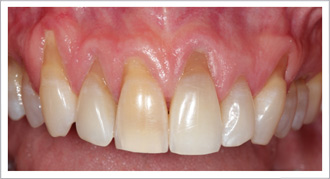
Gums fall down only when the healthy bone below them is infected and it starts dissolving. There are various causes of gums receding like severe gum disease, influence of systemic diseases, lack of oral hygiene, trauma to teeth, some professional hazards like in tailors and beauticians. It can also occur in overly enthusiastic patients who brush their teeth vigorously where the gums would have fallen down without any tartar. This is generally seen only on one side of the mouth.
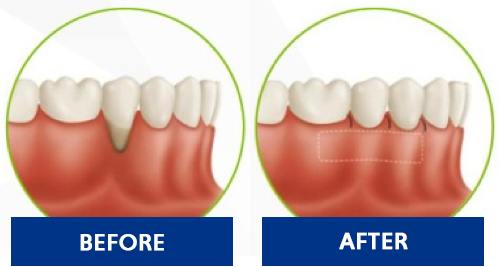
When the gums have fallen and the patient has problem with the elongated teeth especially the front teeth then cosmetic surgery is carried out to bring the gums back in position. This again the periodontist will tell you if the treatment is deemed necessary. So incase if you are tired of your long teeth and want your smile to get in shape book an appointment at V4U Dental Care & Implant Centre for a checkup.
C) Bone regenerative procedures
There are various procedures performed to regain the lost bone due to trauma, disease, abscess, inflammation etc. Bone is regenerated with the help of person’s own bone taken from some other site or by commercially available bone grafts.
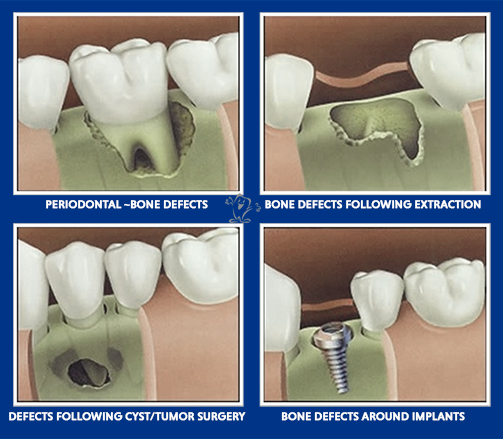
Bone is available from chin, extracted site, side of lower jaw, most hind region of upper jaw. Commercially available grafts are many where they are obtained from other humans, other animals like ox, bovine as well as from artificial elements like plaster of paris, sclera, silica etc.
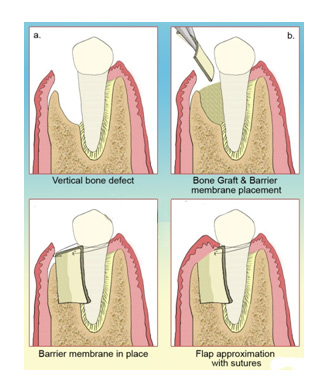
After performing the procedure of adding the graft in defect site it takes 3-6 months for bone formation to occur. Regular checkups are required where x-rays are taken to check for bone density and fill.
D) Treatment of Mobile Teeth
Sometimes the patients complain of mobile teeth as they hinder in chewing process. These teeth may come out of their alignment and cause cosmetic problems too. They hamper the regular oral hygiene procedures also. If you are tired of such culprits and want to get these notorious teeth back in line do visit us at V4U Dental Care & Implant Centre for a checkup. Our extremely skilled periodontist would come to the cause and solution of such teeth in no time and help you get them fixed.
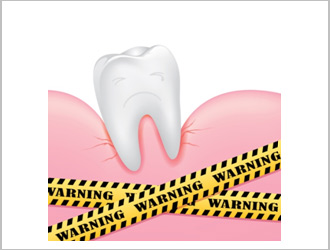
Mobility is not always pathological. So a correct and accurate diagnosis is mandatory to get to the root cause. Sometimes mild mobility is possible during hormonal imbalances like menstruation and pregnancy.
Other pathological causes are presence of systemic diseases like diabetes, any recent trauma to the teeth, any high point on a recent filling, due to severe gum disease like periodontitis, in cases when upper and lower teeth are hitting hard on each other while closing the mouth, in cases when there is a pathology below the apex of the tooth in question.
Thus some investigations are always required to come to correct diagnosis and this can be given the best by a periodontist.
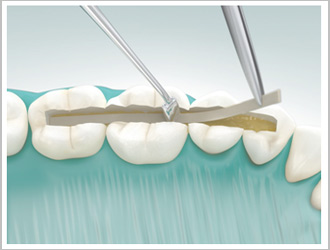
It is a procedure where the loose teeth are bound together with healthy teeth on either side to stabilize them. Once these teeth are steady the load is distributed evenly amongst them and the healing process starts. When they are bound the load is not concentrated on them and the underlying tissues get a chance to repair themselves to get strong again.
But along with this procedure it is important to know the cause of this mobility. Sometimes due to this problem patients get to know about their systemic diseases like diabetes which otherwise goes undetected. Thus a lot of times the dentists give a clue to the underlying systemic diseases to the patients. Hence, it is rightly said that “THE MOUTH IS THE WINDOW OF THE WHOLE BODY”.
Type of splints
There are various splints available. Some are temporary while others are permanent. Based on your cause the periodontist will advice you on the treatment plan.
Temporary splints are wire splints that are bonded on the back of the teeth with composite bonding agents similar to tooth colour. These can be removed once the teeth have become healthy. They are used in case of trauma to the teeth by a knock or a blow.
Permanent splints can also be made of wires that are used after orthodontic treatment/braces when the specialist does not want relapse of the treated teeth. Sometimes a dental bridge can also act as anchor and strengthen them.
Recently fibre splints have come into the market which matches with the tooth colour reducing the unaesthetic effect of the wires.
Points to be kept in mind
In case of splints the dentists at our clinic will advise you to use interdental brushes between teeth so that the splint is not dislodged. They can act as niches for plaque accumulation so an extra caution should be taken to clean the teeth with splints. Regular recall at our clinic is mandatory to get them checked.

There are various splints available. Some are temporary while others are permanent. Based on your cause the periodontist will advice you on the treatment plan.
Temporary splints are wire splints that are bonded on the back of the teeth with composite bonding agents similar to tooth colour. These can be removed once the teeth have become healthy. They are used in case of trauma to the teeth by a knock or a blow.
Permanent splints can also be made of wires that are used after orthodontic treatment/braces when the specialist does not want relapse of the treated teeth. Sometimes a dental bridge can also act as anchor and strengthen them.
Recently fibre splints have come into the market which matches with the tooth colour reducing the unaesthetic effect of the wires.
In case of splints the dentists at our clinic will advise you to use interdental brushes between teeth so that the splint is not dislodged. They can act as niches for plaque accumulation so an extra caution should be taken to clean the teeth with splints. Regular recall at our clinic is mandatory to get them checked.
E) Pre-prosthetic Treatments
These treatments are recommended while replacing missing teeth as they may hinder the prosthetic placement. And who can do it better than a periodontist!! They are a part of the treatment plan which the skilled dentists at our clinic will inform you prior to the commencement of the treatment. These small procedures will enhance your experience to wearing prosthetic teeth by million folds. Sometimes they are carried out as smile enhancement procedures too. So, just relax and leave the job of beautifying your smile on the hand of our expert dentists and behold the miracle that unfolds!!
F) ALVEOLOPLASTY/ ALVEOPLASTY
It is a procedure of reshaping the jaw bone following an extraction. This process smoothens any sharp edges in the area of extracted teeth or otherwise lost teeth. It can be performed immediately after tooth extraction or sometimes as a preparatory process during denture fabrication. At times the area to be replaced has undercuts which hinders the insertion of a denture. In such cases alveoplasty is performed to correct the insertion pathway and make it easy for the patient to wear it by optimising the insertion, comfort and retention.
When a tooth is extracted the area is checked for any overhanging bone that would hamper the healing process. If any uneven margins are present at extraction site then the healing process is hampered and thus this process is carried out to ensure a smooth bone margin for faster healing. Also once a tooth is extracted prior to that the replacement is always in mind of the dentist by either an implant or fixed denture. With this outcome in mind also the process is carried out to form that kind of ridge. This is most helpful in multiple extraction cases as it will give a favourable form to the bone for healing.
In some cases after extraction there are spiky projections in the region and this causes discomfort to the patient’s gums. It causes localized pain while brushing or eating. In these circumstances also alveoplasty is done to remove the pointy projections.
Once the patient is informed about the procedure local anaesthesia is injected in the region to be operated. Once it is confirmed that the area is numb then an incision is given on the edentulous crest region and the gums are raised till the uneven region is exposed. After that with the help of a bone rongeurs or bone files small irregularities are removed. In case of large bony irregularities a hand piece is used. Both the ways abundant amount of irrigation is required to cool the bone as well as to remove the debris. Once the area is smoothened the gums are placed back in position and sutured. After one week the sutures are removed.
G) VESTIBULOPLASTY
It is minor surgical procedure carried out to correct the gingiva-mucous membrane relationship in the vestibule of the mouth. It causes sulcus deepening and extension of ridge without remodelling the bone.
This procedure is mandatory in cases where there is less amount of gingiva for fabrication of dentures. In such cases the denture will not fit properly and thus sufficient amount of gums are needed for denture retention. In severe bone loss cases where fixed prosthesis cannot be placed as the height of gums are very less this procedure is handy. Also in cases when implants have to be placed and there is insufficient amount of attached gingiva vestibuloplasty is carried out to increase the attached gingiva and improve the stability of the implants. It can also be performed in cases with high muscle attachments in the region of lips and cheeks.
There are various techniques used according to the dentists comfort. First local anaesthesia is given to the patient in the region. Then horizontal incision is placed at the mucous membrane and the tissues are pushed below to the desired level. Fenestrations are prepared by exposing the bone and sometimes stay sutures are placed at the base to prevent the tissues from moving. The area is covered with a pack and left to heal. It takes around 15 days for complete healing to take place.
This surgery is very technique sensitive. It can cause temporary paresthesia of the lower teeth region in case the nerve is injured. As this procedure leaves a lot of connective tissue exposed to environment it can be painful to the patient for some time. The procedure heals by scare formation and it can be unaesthetic sometimes. As the raw area is open utter care should be taken not to infect it. Sometimes this procedure has to be repeated till the desired amount of ridge increase is not achieved.
H) FRENECTOMY/ FRENOTOMY
This procedure is again performed during denture fabrication or during the treatment of aligning the teeth.
It is a muscle fold along with fibres present in the middle of upper/lower lips and below the tongue that prevents the movement of lips or tongue beyond the desired range.
Frenectomy is the procedure where complete removal of the frenum along with muscle attachments till the bone is carried out.
Frenotomy is just repositioning of the frenum to a more favourable place.
Removing this muscle should be done only when it is so thick that it hinders in oral hygiene procedures, it causes spacing between front central teeth, when it hinders in fabrication of removal/fixed dentures, when it is associated with shallow vestibule or after braces when the orthodontist wants to remove the muscle from applying pressure on the aligned teeth. It can also be removed when the muscle is attached very high near the teeth that it causes gums to recede and result in sensitivity. Lingual frenum (frenum on tongue) should be removed when it is placed high and it hinders the movement of the tongue leading to speech impairment.
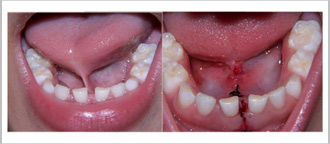
Local anaesthesia is applied and once the area is numb the bulky frenum is held till the depth with a haemostat and a V shaped incision is given on both sides of the instrument. Then after, the incised tissue is removed and a bony fenestration is formed to prevent the muscles from getting attached to their position again. 3-5 sutures are placed in case upper frenum or lingual frenum is removed. Sometimes in upper frenum a pack is placed just to remind patient of the procedure performed.
After one week of excision, the pack and sutures both are removed. The position of the frenum would have changed to the position desired by the dentist. A scar tissue may form but it is not visible as it gets hidden by the lip. Now the patient can perform all the procedures without any disturbance from the extra tissue!!
I) GINGIVECTOMY/ GINGIVOPLATY
This procedure is used to remove extra gingiva from the tooth surface. Again it is performed in collaboration with a prosthodontist, orthodontist or endodontist to give the patients back the charming smile along with enormous self confidence. This multidisciplinary approach is required for such delicate procedures and we at V4U Dental Care & Implant Centre have very cooperative and skilled team of specialists from all braches who would work tirelessly to give you an infectious smile like never before!!
Gingivectomy is the procedure of complete excision of gingiva where as gingivoplasty involves only reshaping the gingival tissue as desired.
Gingivectomy is performed to remove gum overgrowth on the tooth due to inflammation or as an influence of some drugs/medications. It is also a part of treatment of pyorrhoea where it is performed to remove the infected gums. It is also performed on bulky, round gum margins to get the normal contour of the gums. A short tooth with bulbous margins can be brought back to its actual shape and length with this procedure. It can be carried to expose additional tooth surface to gain extra retention for restoration on the tooth; this process is called crown lengthening where sometimes little bone also has to be removed with the gums to maintain harmony of the periodontium.
Gingivoplasty is carried out to create a normal gum contour that aide in better oral hygiene procedures and gives an extra spark to your radiating SMILE!!
Gingivectomy is a very simple, safe procedure to get an instant result, but even it cannot be performed in some conditions like pockets below the bone level, when bone regeneration is to be performed. Even when the gums are soft it is contraindicated as a nice incision is not possible.
This procedure can be performed by surgical blades or by laser.
After administration of local anaesthetic, once the area is numb; the pockets are marked with a specialised instrument called pocket marker and bleeding points are created. After that a surgical blade is used to cut the marked line with stab incision. Thereafter, the rugged margins are smoothened with a kidney shaped knife to get a nice slop on the gingiva. This recreates the normal shape of gums. Sometimes a raw wound is left after the procedure which is covered with a dressing. The patient is informed to keep the dressing in place for a week. After one week the patient is called back. Then lo and behold the bulky, rough gums are back to their original beauty!!
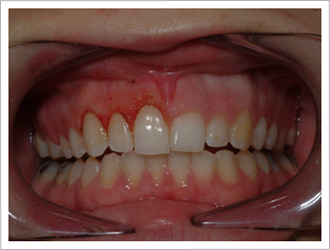
Laser has an advantage that it produces a bloodless field which enhances visibility and work efficiency. But simultaneously the healing of laser is little delayed and utmost care should be taken not to touch the bone as it causes irreparable damage to the bone. Our specialist would see the pros and cons and wherever laser can be used it would be informed to the patient.
J) TREATMENT OF BONY ENLARGEMENTS/ EXOSTOSIS/TORI
Some patients have extra bony enlargements that can hinder prosthesis placement as well it can prove to be unaesthetic when present on the front teeth. In such cases these protuberances have to be eliminated.
Sometimes these bony enlargements are present from birth and the patient does not have any idea about them. Only complain could be that oral hygiene is hampered or they can have regular ulcers present on the enlargements due to trauma.
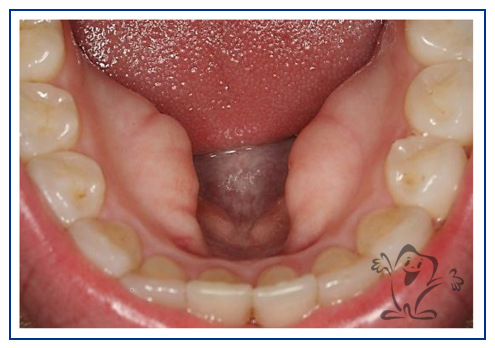
In upper jaw tori is mostly present on the palate in the centre. In lower jaw they are present in region near the tongue mostly at premolars. These enlargements can also be caused on the cheek facing bone surface just above the teeth either from birth or as a response to occlusal trauma. These enlargements are not malignant but can be an aggravating factor in progression of gum disease when they grow too large.
Generally these tori are painless and thus the patient has no idea about them. Again mostly they are present from beginning so the patient gets used to the enlargement. They only come to know about them once these enlargements get ulcerated due to any trauma or during a routine checkup at a dental clinic.
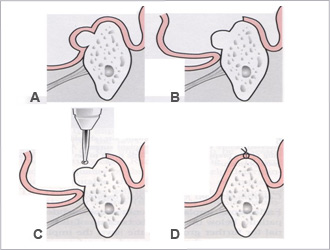
A) A lingual tours is covered by thin oral mucosa and considerable care is required to avoid accidental perforation of the flap.
B) The muco-periosteal flap is raised to expose teh entire bony mass.
C) A surgical bur or chisel may be used to remove the bony torus
D) The woulnd is closed with multiple resorbable sutures
Mostly these protuberances are harmless and thus they do not need to be removed. But when prosthesis is being fabricated and its retention is compromised then is the time to remove these biggies. This procedure is performed under local anaesthesia where the gums are raised and the bony enlargements are trimmed to correct level by a motor driven handpiece and cutting burs. The rugged bone is then smoothened by bone files and the gums are placed back and sutured.
This is an uncomplicated procedure where the bone is removed. It forms a normal contour of the bone which helps in enhancing oral hygiene. It also helps in increasing the retention of any prosthesis by removing these enlargements.
K) CROWN LENGTHENING
This procedure is performed to increase the surface area of a severely broken tooth to aid in increasing the retention of the restoration. This procedure is carried out by the dentists to create a good emerging profile of the restored tooth.
This technique is performed in cases where restoration retention is compromised and sometimes to increase the length of tooth for smile designing.
This procedure involves working under local anaesthetic. It starts with cutting the gums circumferentially and then opening the gums to trim the bone. After this the gums are placed at a little higher level to increase the tooth exposed in mouth and then sutured. This is done to maintain the necessary distance between the bone and the restorative material.
L) LOCAL RIDGE AUGMENTATION
Are you tired of the space seen between your fixed bridge and bone? Does this discourage you to flaunt your perfect smile? Increase in jaw height can be performed by either increasing your bone height or by increasing your gum thickness. Then, we at V4U Dental Care & Implant Centre have the best skilled and delicate hands at work to make your experience as comfortable as possible and perform such delicate procedures to increase the height of your jaw bone. Hence, leave your worries in our hands and allow us to make the architectural wonder be possible where you will never repent!!
This is the procedure where the bone is increased by adding either patient’s own bone taken from some other site or by some commercially available products. This is one technique which is very sensitive and its prediction is not certain incase if the defect is big and wide. But it provides an opportunity to the dentist to try and increase the bone width and height to enhance the cosmetic beauty of any restoration carried out to replace missing teeth. This is one procedure which has a lot of alterations being carried out due to various bone grafts available or the procedures are modified according the specialists ease and comfort.
When a removable denture is given as times goes by there is some amount of bone loss occurring. So to compensate for this loss ridge augmentation is carried out. In cases of severe gum disease where there is extensive vertical bone loss the area is filled with bone forming powder/grafts to enhance bone formation. Also sometimes in cases of fixed bridges due to loss of bone space occurs between the bridge and ridge which gives a very unpleasing appearance especially in front teeth. Then ridge augmentation is carried out either by bone formation or by adding gums on the ridge.
Hard tissue means increasing the ridge with the help of bone. Here, after sufficient local anaesthesia is administered the gums are opened with the surgical blade. The bone is cut or holes are punched and then bone graft from the same patient taken from some other site is placed on the ridge and secured with titanium screws. After that the gap is filled with commercially available bone forming granules and the gums are placed back and sutured. The area is covered with dressing and the sutures are removed after a week. The region is left untouched from 3-5 months as it takes around that much time for the bone to fuse with the existing ridge.
When the gap between the fixed bridge and ridge is less then this procedure is carried out. This is again a very technique sensitive procedure. In this procedure the gums of the area in question are scrapped off their epithelium or the outer covering and the underlying soft tissue is exposed. A small amount of gum is removed of some other region of the mouth and it is placed on this exposed tissue and sutured. The area is packed with dressing and sutures are removed after 10 days. This procedure helps to increase the bone height by applying more soft tissue to the region.
Hard tissue or bone can be obtained from chin, side of lower jaw, most behind region of upper jaw called tuberosity.
Soft tissue or gums are taken from palate of upper jaw, most behind region of lower jaw.
The procedures are very technique sensitive. But most important is how the body reacts to the grafts placed. In some cases the grafts completely necrose leaving the same defect as when the procedure had started. There can be infection on the donor or recipient site. Sometimes swelling can be present on the treated site for 2-3 days.
